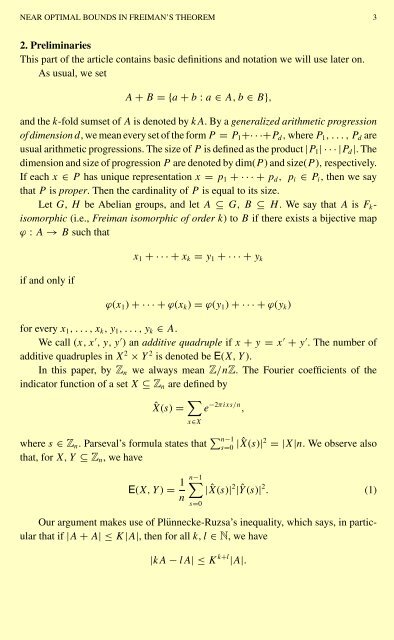NEAR OPTIMAL BOUNDS IN FREIMAN'S THEOREM
NEAR OPTIMAL BOUNDS IN FREIMAN'S THEOREM
NEAR OPTIMAL BOUNDS IN FREIMAN'S THEOREM
You also want an ePaper? Increase the reach of your titles
YUMPU automatically turns print PDFs into web optimized ePapers that Google loves.
<strong>NEAR</strong> <strong>OPTIMAL</strong> <strong>BOUNDS</strong> <strong>IN</strong> FREIMAN’S <strong>THEOREM</strong> 3<br />
2. Preliminaries<br />
This part of the article contains basic definitions and notation we will use later on.<br />
As usual, we set<br />
A + B ={a + b : a ∈ A, b ∈ B},<br />
and the k-fold sumset of A is denoted by kA.Byageneralized arithmetic progression<br />
of dimension d, we mean every set of the form P = P1+···+Pd, where P1,...,Pd are<br />
usual arithmetic progressions. The size of P is defined as the product |P1|···|Pd|.The<br />
dimension and size of progression P are denoted by dim(P ) and size(P ), respectively.<br />
If each x ∈ P has unique representation x = p1 +···+pd, pi ∈ Pi, thenwesay<br />
that P is proper. Then the cardinality of P is equal to its size.<br />
Let G, H be Abelian groups, and let A ⊆ G, B ⊆ H . We say that A is Fkisomorphic<br />
(i.e., Freiman isomorphic of order k) toB if there exists a bijective map<br />
ϕ : A → B such that<br />
if and only if<br />
x1 +···+xk = y1 +···+yk<br />
ϕ(x1) +···+ϕ(xk) = ϕ(y1) +···+ϕ(yk)<br />
for every x1,...,xk,y1,...,yk ∈ A.<br />
We call (x,x ′ ,y,y ′ ) an additive quadruple if x + y = x ′ + y ′ . The number of<br />
additive quadruples in X2 × Y 2 is denoted be E(X, Y ).<br />
In this paper, by Zn we always mean Z/nZ. The Fourier coefficients of the<br />
indicator function of a set X ⊆ Zn are defined by<br />
ˆX(s) = <br />
e −2πixs/n ,<br />
x∈X<br />
where s ∈ Zn. Parseval’s formula states that n−1<br />
s=0 | ˆX(s)| 2 =|X|n. We observe also<br />
that, for X, Y ⊆ Zn, wehave<br />
E(X, Y ) = 1 n−1<br />
| ˆX(s)|<br />
n<br />
2 | ˆY (s)| 2 . (1)<br />
s=0<br />
Our argument makes use of Plünnecke-Ruzsa’s inequality, which says, in particular<br />
that if |A + A| ≤K|A|, then for all k, l ∈ N, wehave<br />
|kA − lA| ≤K k+l |A|.

















